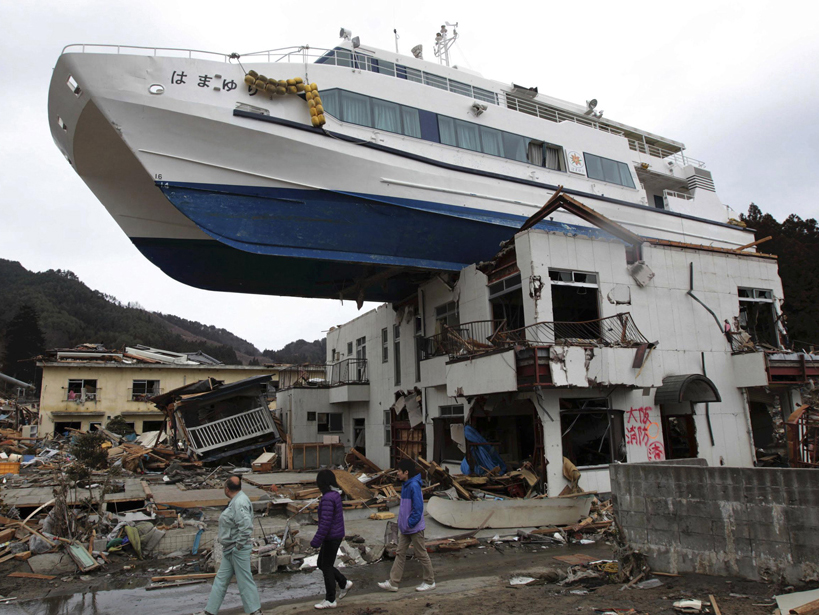Scientists studying the massive subduction zone off the east coast of Japan have found a correlation between earthquakes and periodic events called “slow slip” wherein the plate moves but the motion produces no discernable seismic signature. The new insight, published online on 28 January in Science, may help scientists better forecast the likelihood of large earthquakes.
When slow-slip events occur, “the possibility of earthquakes [is] higher than normal” because of the stress from the slow-slip events, said Naoki Uchida, lead author on the paper and a seismologist at Tohoku University in Sendai, Japan.
Slowly Slipping Plates
Slow-slip or “aseismic” events can occur at any plate boundary but are observed most clearly in subduction zones. In this study, Uchida and his colleagues investigated those events where the Pacific Plate, an oceanic slab of the Earth’s crust, creeps underneath the continental Okhotsk Plate. Such aseismic motions occur over weeks or months, unlike earthquakes, which happen in seconds.
Slow slip does not produce seismic waves, so seismometers cannot observe it. Rather, scientists track the small, slow movements by recording the motion of GPS receivers buried in the ground. In the Cascadia Subduction Zone off the U.S. Pacific Northwest, for instance, seismologists detect slow-slip events about once every 15 months. These events happen so slowly that the energy equivalent of a magnitude 6.5 event can occur over the course of a month—without anyone even feeling it.
Seismologists have observed slow-slip events in the days following large earthquakes. They have long suspected a connection between those events and earthquakes, but if and how the two are related has remained a mystery.
Japan’s Slow Slip
This new study delves deeper into the relationship between slow-slip events and larger, felt earthquakes along a subduction zone running parallel to the northeastern coast of Japan. The Japan Trench is notorious for producing large, devastating earthquakes, such as the 2011 Tohoku earthquake and the tsunami it unleashed, which caused more than 15,000 deaths, 300 billion dollars in damage, and a nuclear reactor meltdown.
The researchers looked at 28 years’ worth of data to find small “repeater” earthquakes along the subduction zone, said Roland Bürgmann, a coauthor on the new paper and a seismologist at the Berkeley Seismological Laboratory at the University of California. These small earthquakes occur frequently, acting as a beacon of sorts that leads scientists to slow-slip events.
“With thousands of such events in northeast Japan, we can resolve small and large slow-slip events that occurred during the last few decades.”
Stress caused by the slowly slipping Pacific Plate moving beneath the Okhotsk Plate breaks “small stuck patches,” and seismologists detect the breakage as repeater quakes, Bürgmann said. The authors inferred that where the repeaters occur along the plate matches with the location of slow-slip events. In turn, the frequency of repeaters allows researchers to determine how often the plate slipped aseismically, said Robert Nadeau, another coauthor and seismologist at the Berkeley Seismological Laboratory.
“With thousands of such events in northeast Japan, we can resolve small and large slow-slip events that occurred during the last few decades,” Bürgmann said.
Better Earthquake Forecasts?
The researchers evaluated more than 6000 repeaters and the slow slip that caused them and found a relatively stable periodicity of slow-slip events—they occur every 1–6 years in some places and every 2–3 years in other places along the subduction zone. The researchers then looked at the occurrence of large earthquakes—magnitude 5 and above—in relation to slow slip and found that when the rate of slow-slip events increased, earthquakes were much more likely to occur. They even found a swarm of slow-slip events along the fault preceding the Tohoku earthquake. The correlation between higher rates of slow-slip events and large earthquakes will hopefully allow for “the development of more precise and shorter-term earthquake forecasts,” Bürgmann said.
It is highly unlikely that scientists will find a way to predict an earthquake on the basis of slow-slip events alone.
Predicting specific earthquakes remains impossible, according to the U.S. Geological Survey (USGS). However, these new findings and possible future strides in quantifying the relationship between slow slip and earthquakes could lead to better forecasting, said Nadeau. However, he added that it is highly unlikely that scientists will find a way to predict an earthquake on the basis of slow-slip events alone.
In addition, the slow-slip events were inferred from repeaters, rather than from remote GPS measurements, said Evelyn Roeloffs, a research geophysicist at USGS in Vancouver, Wash., who did not take part in the new study. “Slow-slip events in subduction zones depart from periodicity in other subduction zones—this location may be unique. The periodicity is not perfect, and it is difficult to quickly assimilate the details in the paper fully enough to decide how strong the observation is.”
John Vidale, director of the Pacific Northwest Seismic Network and professor at the University of Washington, Seattle, who was not involved in the study, lauded the new work as a starting point for more research. “The degree of extra accuracy possible in hazard estimation is not yet clear, but, thanks to Uchida et al., additional work in this direction is now an urgent need.”
—JoAnna Wendel, Staff Writer
Citation: Wendel, J. (2016), Subtle seismic movements may help forecast large earthquakes, Eos, 97, doi:10.1029/2016EO045137. Published on 1 February 2016.
Text © 2016. The authors. CC BY-NC 3.0
Except where otherwise noted, images are subject to copyright. Any reuse without express permission from the copyright owner is prohibited.

